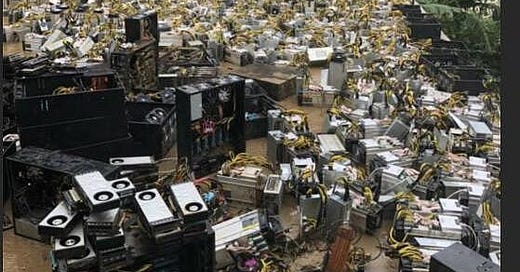Equity prices depend on valuations and reflexivity. When reflexivity dominates, bubbles form. The dot-com bubble is the most famous example. A vicious crash followed that lasted for three years. It took 14 years for the Nasdaq-100 total return to recapture the 2000 highs. Without quantitative easing and a long period of rates close to zero, new all-time highs would have been highly unlikely even by now. Yet, even after the last massive fiscal stimulus, not all technology stocks have benefited; the ARKK ETF remains 72% below the February 2021 all-time highs. When the bulk of the price gains are due to reflexivity and not fundamental valuations, recovery can take a long time, or it may not even happen. What is the story behind Nvidia’s recent meteoric rise?
Everyone who knows me knows I avoid making predictions. I like boring and slow systematic trading and some occasional discretionary positions. I leave predictions to those who have special abilities to see into the future. But I was tempted to write about the Nvidia bubble just before the stock split.
Nvidia is a classic and rare case of a three-stage bubble. Unfortunately, there won’t be a fourth stage. Don’t ask why; it could take a whole book to explain it. Since the bottom of the market in October 12, 2022, the S&P 500 index has gained 49%. However, Nvidia (NVDA) has surged 944%! The market cap has exploded to nearly $3T! Why?
Artificial intelligence, of course! The chips and GPUs Nvidia makes will make artificial intelligence a reality. This is the thesis. Does this thesis justify the meteoric rise?
Never look for justification in games dominated by fear and greed. It is what it is. This stock has dominated the S&P 500 cap-weighted index and has created a spill-over effect that has lifted equity prices, but not in a broad sense. Market internals are weak. Since October 12, 2022, although the S&P 500 index has gained 49%, the equal-weight counterpart has only gained 27.3%. Although Nvidia has not been the sole cause of this wide divergence, it has nevertheless greatly contributed to it.
Nvidia is in the last stage of a reflexivity bubble. The first stage started in August 2015. Expectations that blockchain would be a major problem solver for humanity were elaborated in articles daily in financial and social media. The noise was unbearable. The blockchain hype ended when it became apparent that it was a solution looking for problems. Nvidia fell nearly 55%.
Then, the crypto and Defi bubble started. When inflation started rising due to a pandemic supply shock and wars, high costs hit mining, and GPUs ended up in dumpsters after the closure of mining operations. By mid-October 2022, Nvidia had decreased by more than 65% and was also suffering from a general market decline.
Deus ex machina: the AI hype starts. Some people claim they found the key to artificial intelligence, something that thousands of scientists and philosophers of science have been unable to do in the past and it is exactly this: fast GPUs from Nvidia to scan online content and deduce the secrets of the universe. This is stage three of the bubble.
Bubbles are opportunities for astute market participants to profit and exit before the crowds enter the market, leaving millions of bagholders behind. After all, one of the main functions of bubble markets is wealth-redistribution. I have no idea when the Nvidia bubble will end. I have no special powers to predict the future. I am only guessing based on what I have seen in the markets in the last 35 years. I suspect the bubble will continue for up to one more year. By that time, it will become evident that what people describe as artificial intelligence is some form of fancy data science. This is useful too, and some good products will be developed, but far away from the promises. Then, the decline to a rational price will start. Given that the reflexivity component will no longer contribute, the price will depend on fundamental valuations. Earnings will play an important role. I expect a massive retracement to the 2023 highs. The stock could rise to 2,000 (or 200 after the split). A fall to 2023 highs would represent a 75% drop.
Therefore, there is money to be made and lost. There will be winners, including insiders who will sell stock, but many more losers and bagholders. This is the nature of bubbles. Nvidia is now a bubble. The bubble will burst.
I have no position in the stock, long or short. I may go long and, at some point, short with puts. All usual risk disclaimers apply. No part of this article constitutes an offer to buy or sell any sort of security or financial product. Furthermore, no part of this article should be construed as advice or a recommendation for any type of financial transaction or investment decision. I am not a financial adviser.





